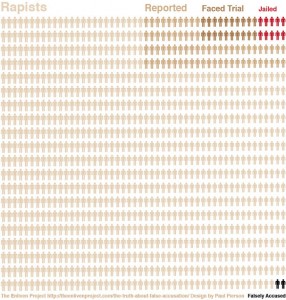 A week or so ago I read Dylan Matthews’ Washington Post piece, “The Saddest Graph You’ll See Today.” The article focuses on an infographic illustrating the small percentage of rapes that are reported and an even smaller numbers of rapists who are jailed. Recognizing the complexity of collecting data about and unreported rape, I hesitated to share this specific explanation without some form of methodological disclaimer. Interestingly when I returned to the article, Matthews had provided an update doing just that.
A week or so ago I read Dylan Matthews’ Washington Post piece, “The Saddest Graph You’ll See Today.” The article focuses on an infographic illustrating the small percentage of rapes that are reported and an even smaller numbers of rapists who are jailed. Recognizing the complexity of collecting data about and unreported rape, I hesitated to share this specific explanation without some form of methodological disclaimer. Interestingly when I returned to the article, Matthews had provided an update doing just that.
The data depicted on the infographic is “the Enliven Project using data from Department of Justice’s National Crime Victimization Survey and FBI reports.” Matthew’s update links to Amanda Marcotte’s critique, which offers an alternative perspective while still agreeing that “most rapes go unreported.”
So What?
Regardless of whether you think the infographic displayed here is the most accurate depiction possible, it is important to be aware that most rapes go unreported. As people of faith, we must seek to be agents of change laboring to ensure the safety and well-being of all people. If a crime as serious as rape is typically unreported, then something remains wrong with our current system. How do you suggest individuals and congregations become advocates for helpful change?